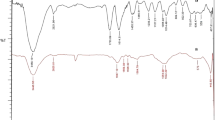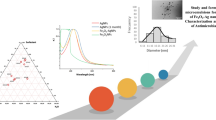Abstract
Purpose
The aim was to design and thoroughly characterize monodisperse Fe3O4@SiO2-Ag nanoparticles with strong antibacterial properties, which makes them a candidate for targeting bacterial infections.
Methods
The monodisperse Fe3O4 nanoparticles were prepared by oleic acid-stabilized thermal decomposition of Fe(III) oleate; the particles were coated with silica shell using a water-in-oil reverse microemulsion, involving hydrolysis and condensation of tetramethyl orthosilicate. Resulting Fe3O4@SiO2 particles were modified by (3-mercaptopropyl)trimethoxysilane to introduce 1.1 mmol SH/g. Finally, the Fe3O4@SiO2-SH nanoparticles were decorated with silver nanoclusters formed by reduction of silver nitrate with NaBH4. The particles were analyzed by FTIR, X-ray photoelectron and atomic absorption spectroscopy, dynamic light scattering and vibrating sample magnetometry. The antibacterial activity of the Fe3O4@SiO2 and Fe3O4@SiO2-Ag nanoparticles was tested against Gram-positive Staphylococcus aureus and Gram-negative Escherichia coli bacteria cultivated on Luria agar plates or in Luria broth.
Results
The superparamagnetic Fe3O4@SiO2-Ag nanoparticles (21 nm in diameter; saturation magnetization 26 A∙m2/kg) were successfully obtained and characterized. Inhibitory and toxic effects against bacteria were documented by incubation of the Fe3O4@SiO2-Ag nanoparticles with Staphylococcus aureus and Escherichia coli.
Conclusions
The combination of magnetic properties together with bactericidal effects is suitable for the disinfection of medical instruments, water purification, food packaging, etc.









Similar content being viewed by others
Abbreviations
- AAS:
-
Atomic absorption spectrometer
- Amp:
-
Ampicillin
- CFU:
-
Colony forming units
- Ð :
-
Dispersity
- D h :
-
Hydrodynamic diameter
- DLS:
-
Dynamic light scattering
- D n :
-
Number-average diameter
- DT:
-
1-Dodecanethiol
- D w :
-
Weight-average diameter
- E. coli :
-
Escherichia coli
- Igepal CO-520:
-
Polyoxyethylene(5) nonylphenylether
- IS:
-
Icosane
- LA:
-
Luria agar plates
- LB:
-
Luria broth
- MPTMS:
-
(3-Mercaptopropyl)trimethoxysilane
- NT:
-
No treatment controls
- OA:
-
Oleic acid
- OD:
-
Octadec-1-ene
- PBS:
-
Phosphate buffered saline
- PI :
-
Polydispersity index
- S. aureus :
-
Staphylococcus aureus
- SAM:
-
Self-assembled monolayer
- SBH:
-
Sodium borohydride
- TEM:
-
Transmission electron microscope
- TMOS:
-
Tetramethyl orthosilicate
- XPS:
-
X-ray photoelectron spectroscopy
References
Spellberg B, Guidos R, Gilbert D, Bradley J, Boucher HW, Scheld WM, et al. The epidemic of antibiotic-resistant infections: a call to action for the medical community from the Infectious Diseases Society of America. Clin Infect Dis. 2008;46:155–64.
Roca I, Akova M, Baquero F, Carlet J, Cavaleri M, Coenen S, et al. The global threat of antimicrobial resistance: science for intervention. New Microbes New Infect. 2015;16:22–9.
Lam SJ, Wong EHH, Boyer C, Qiao GQ. Antimicrobial polymeric nanoparticles. Prog Polym Sci. 2018;76:40–64.
Wang L, Hu C, Shao L. The antimicrobial activity of nanoparticles: present situation and prospects for the future. Int J Nanomedicine. 2017;12:1227–49.
Jennings MC, Minbiole KPC, Wuest WM. Quaternary ammonium compounds: an antimicrobial mainstay and platform for innovation to address bacterial resistance. ACS Infect Dis. 2015;1:288–303.
Kim J, Pitts B, Stewart PS, Camper A, Yoon J. Comparison of the antimicrobial effects of chlorine, silver ion, and tobramycin on biofilm. Antimicrob Agents Chemother. 2008;52:1446–53.
Draper LA, Cotter PD, Hill C, Ross RP. Lantibiotic resistance. Microbiol Mol Biol Rev. 2015;79:171–91.
Clement JL, Jarrett PS. Antibacterial silver. Met Based Drugs. 1994;1:467–82.
Kędziora A, Speruda M, Krzyżewska E, Rybka J, Łukowiak A, Bugla-Płoskońska G. Similarities and differences between silver ions and silver in nanoforms as antibacterial agents. Int J Mol Sci. 2018;19:444.
Radtsig MA, Koksharova OA, Khmel IA. Antibacterial effects of silver ions: effect on gram-negative bacteria growth and biofilm formation. Mol Genet Microbiol Virol. 2009;4:194–9.
Gao SS, Zhao IS, Duffin S, Duangthip D, Lo ECM, Chu CH. Revitalising silver nitrate for caries management. Int J Environ Res Public Health. 2018;15:80.
Sun Y, Xia Y. Shape-controlled synthesis of gold and silver nanoparticles. Science. 2002;298:2176–9.
Panacek A, Kvítek L, Prucek R, Kolar M, Vecerova R, Pizúrova N, et al. Silver colloid nanoparticles: synthesis, characterization, and their antibacterial activity. J Phys Chem B. 2006;110:16248–53.
Cornell RM, Schwertmann U. The Iron oxides: structure, properties, reactions, occurrences and uses. second ed. Darmstadt, Germany: Wiley; 2000.
Laurent S, Forge D, Port M, Roch A, Robic C, van der Elst L, et al. Magnetic iron oxide nanoparticles: synthesis, stabilization, vectorization, physicochemical characterizations, and biological applications. Chem Rev. 2008;108:2064–110.
Chaudhuri GR, Paria S. Core/shell nanoparticles: classes, properties, synthesis mechanisms, characterization, and applications. Chem Rev. 2012;11:2373–433.
Bergna HE, Roberts WO. Colloidal silica: fundamentals and applications. Santa Barbara, USA: CRC Press; 2005.
Stöber W, Fink A. Controlled growth of monodisperse silica spheres in the micron size range. J Colloid Interface Sci. 1968;26:62–9.
Prabhu YT, Rao KV, Kumari BS, Kumar VSS, Pavani T. Synthesis of Fe3O4 nanoparticles and its antibacterial application. Int Nano Lett. 2015;5:85–92.
Ismail RA, Sulaiman GM, Abdulrahman SA, Marzoog TR. Antibacterial activity of magnetic iron oxide nanoparticles synthesized by laser ablation in liquid. Mater Sci Eng C. 2015;53:286–97.
Bhattacharya P, Neogi S. Gentamicin coated iron oxide nanoparticles as novel antibacterial agents. Mater Res Express. 2017;4:095005.
Mahmoudi M, Serpooshan V. Silver-coated engineered magnetic nanoparticles are promising for the success in the fight against antibacterial resistance threat. ACS Nano. 2012;6:2656–64.
Prucek R, Tuček J, Kilianová M, Panáček A, Kvítek L, Filip J, et al. The targeted antibacterial and antifungal properties of magnetic nanocomposite of iron oxide and silver nanoparticles. Biomaterials. 2011;32:4704–13.
Jiang J, Gu H, Shao H, Devlin E. Bifunctional Fe3O4–Ag heterodimer nanoparticles for two-photon fluorescence imaging and magnetic manipulation. Adv Mater. 2008;20:4403–7.
Liu XM, Li YS. One-step facile fabrication of Ag/γ-Fe2O3 composite microspheres. Mater Sci Eng C. 2009;29:1128–32.
Lee D, Cohen RE, Rubner MF. Antibacterial properties of ag nanoparticle loaded multilayers and formation of magnetically directed antibacterial microparticles. Langmuir. 2005;21:9651–9.
Zhang X, Niu H, Yan J, Cai Y. Immobilizing silver nanoparticles onto the surface of magnetic silica composite to prepare magnetic disinfectant with enhanced stability and antibacterial activity. Colloid Surf A. 2011;375:186–92.
Patsula V, Petrovský E, Kovářová J, Konefal R, Horák D. Monodisperse superparamagnetic nanoparticles by thermolysis of Fe(III) oleate and mandelate complexes. Colloid Polym Sci. 2014;292:2097–110.
Kostiv U, Patsula V, Šlouf M, Pongrac IM, Škokić S, Dobrivojević Radmilović M, et al. Physico-chemical characteristics, biocompatibility, and MRI applicability of novel monodisperse PEG-modified magnetic Fe3O4&SiO2 core–shell nanoparticles. RSC Adv. 2017;7:8786–97.
Kostiv U, Janoušková O, Šlouf M, Kotov N, Engstová H, Smolková K, et al. Silica-modified monodisperse hexagonal lanthanide nanocrystals: synthesis and biological properties. Nanoscale. 2015;7:18096–104.
Ding HL, Zhang YX, Wang S, Xu JM, Xu SC, Li GH. Fe3O4@SiO2 core/shell nanoparticles: the silica coating regulations with a single core for different core sizes and shell thicknesses. Chem Mat. 2012;24:4572–80.
Li M, Wu W, Qiao R, Tan L, Li Z, Zhang Y. Ag-decorated Fe3O4@SiO2 core-shell nanospheres: seed-mediated growth preparation and their antibacterial activity during the consecutive recycling. J Alloys Compd. 2016;676:113–9.
Cai Y, Tan F, Qiao X, Wang W, Chen J, Qiu X. Room-temperature synthesis of silica supported silver nanoparticles in basic ethanol solution and their antibacterial activity. RSC Adv. 2016;6:18407–12.
Baumgartner J, Bertinetti L, Widdrat M, Hirt AM, Faivre D. Formation of magnetite nanoparticles at low temperature: from superparamagnetic to stable single domain particles. PLoS One. 2013;8:e57070.
Garland ER, Rosen EP, Clarke LI, Baer T. Structure of submonolayer oleic acid coverages on inorganic aerosol particles: evidence of island formation. Phys Chem Chem Phys. 2008;10:3156–61.
Dunlop D, Ozdemir O. Rock Magnetism: Fundamentals and Frontiers. Cambridge, UK: Cambridge University Press; 1997.
Demortiere A, Panissod P, Pichon BP, Pourroy G, Guillon D, Donnio B, et al. Size-dependent properties of magnetic iron oxide nanocrystals. Nanoscale. 2011;3:225–32.
Li Q, Kartikowati CW, Horie S, Ogi T, Iwaki T, Okuyama K. Correlation between particle size/domain structure and magnetic properties of highly crystalline Fe3O4 nanoparticles. Sci Rep. 2017;7:9894.
Iida H, Takayanagi K, Nakanishi T, Osaka T. Synthesis of Fe3O4 nanoparticles with various sizes and magnetic properties by controlled hydrolysis. J Colloid Interface Sci. 2007;314:274–80.
Hajipour MJ, Fromm KM, Ashkarran AA, Aberasturi DJ, Larramendi IR, Rojo T, et al. Antibacterial properties of nanoparticles. Trends Biotechnol. 2012;30:499–511.
Sondi I, Salopek-Sondi B. Silver nanoparticles as antimicrobial agent: a case study on E. coli as a model for gram-negative bacteria. J Colloid Interface Sci. 2004;275:177–82.
Kim JS, Kuk E, Yu KN, Kim JH, Park SJ, Lee HJ, et al. Antimicrobial effects of silver nanoparticles. Nanomed Nanotechnol Biol Med. 2007;3:95–101.
Yuan YG, Peng QL, Gurunathan S. Effects of silver nanoparticles on multiple drug-resistant strains of Staphylococcus aureus and Pseudomonas aeruginosa from mastitis-infected goats: an alternative approach for antimicrobial therapy. Int J Mol Sci. 2017;18:569.
Matsumura Y, Yoshikata K, Kunisaki S, Tsuchido T. Mode of bactericidal action of silver zeolite and its comparison with that of silver nitrate. Appl Environ Microbiol. 2003;69:4278–81.
Feng QL, Wu J, Chen GQ, Cui FZ, Kim TN, Kim JO. A mechanistic study of the antibacterial effect of silver ions on Escherichia coli and Staphylococcus aureus. J Biomed Mater Res. 2000;52:662–8.
Abbaszadegan A, Ghahramani Y, Gholami A, Hemmateenejad B, Dorostkar S, Nabavizadeh M, et al. The effect of charge at the surface of silver nanoparticles on antimicrobial activity against gram-positive and gram-negative bacteria: a preliminary study. J Nanomater. 2015;2015:720654.
Yoon SS, Barrangou-Poueys R, Breidt F, Fleming HP. Detection and characterization of a lytic Pediococcus bacteriophage from the fermenting cucumber brine. J Microbiol Biotechnol. 2007;17:262–70.
Pal S, Tak YK, Song JM. Does the antibacterial activity of silver nanoparticles depend on the shape of the nanoparticle? A study of the gram-negative bacterium Escherichia coli. Appl Environ Microbiol. 2007;73:1712–20.
Neal AL. What can be inferred from bacterium-nanoparticle interactions about the potential consequences of environmental exposure to nanoparticles? Ecotoxicology. 2008;17:362–71.
Vidanapathirana AK, Thompson LC, Herco M, Odom J, Sumner SJ, Fennell TR, et al. Acute intravenous exposure to silver nanoparticles during pregnancy induces particle size and vehicle dependent changes in vascular tissue contractility in Sprague Dawley rats. Reprod Toxicol. 2018;75:10–22.
Li L, Cui J, Liu Z, Zhou X, Li Z, Yu Y, et al. Silver nanoparticles induce SH-SY5Y cell apoptosis via endoplasmic reticulum- and mitochondrial pathways that lengthen endoplasmic reticulum–mitochondria contact sites and alter inositol-3-phosphate receptor function. Toxicol Lett. 2018;285:156–67.
Jiang X, Lu C, Tang M, Yang Z, Jia W, Ma Y, et al. Nanotoxicity of silver nanoparticles on HEK293T cells: a combined study using biomechanical and biological techniques. ACS Omega. 2018;3:6770–8.
Sahu SC, Zheng J, Graham L, Chen L, Ihrie J, Yourick JJ, et al. Comparative cytotoxicity of nanosilver in human liver HepG2 and colon Caco2 cells in culture. J Appl Toxicol. 2014;34:1155–66.
Author information
Authors and Affiliations
Corresponding author
Additional information
Publisher’s Note
Springer Nature remains neutral with regard to jurisdictional claims in published maps and institutional affiliations.
Rights and permissions
About this article
Cite this article
Shatan, A.B., Venclíková, K., Zasońska, B.A. et al. Antibacterial Silver-Conjugated Magnetic Nanoparticles: Design, Synthesis and Bactericidal Effect. Pharm Res 36, 147 (2019). https://doi.org/10.1007/s11095-019-2680-x
Received:
Accepted:
Published:
DOI: https://doi.org/10.1007/s11095-019-2680-x




